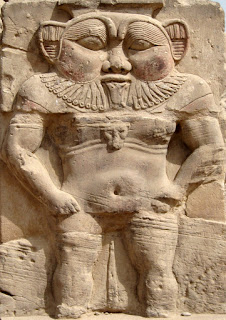 |
| H.R Giger's Black Room, Egyptian Burial chamber, on the third floor of his parents' house at Storchengrasse 17, Chur, 1958 (source, WWW.HRGIGER.COM (book) p9) |
b) When he was about six years, every Sunday he went to the civic museum in Chur and in the basement with the amputated hands and feet they kept a beautiful mummified body of what he believed was an Egyptian princess and her sarcophagus.
c) His keen interest in such Egyptian imagery can be seen on the decorations of the wall of his black room (above) where he used to hold parties and play with his band as a teenager. In the centre of the photo is an image of the God Ra holding a was-sceptre.
d) The way he did his portraits Giger consider typically Egyptian as well, in the way they presented a view from from the side and the front. So the Egyptian style was something that he considered part of his way of expressing through art.
 |
 |
| Aker or Ruti, the god in the form of two lions |
Looking for signs of the variations of Bes in the details
- Vincent Castiglia- - Co uważasz za źródło największej inspiracji?
HR Giger- Starożytnych Egipcjan. Gdy miałem ok. 6 lat, co niedzielę chodziłem do muzeum w Chur. W piwnicy trzymali tam piękną mumię. Miała stary zapach i to mnie fascynowało. Później, gdy zacząłem rysować i używać airbrush, tamto wspomnienie było dla mnie dużą inspiracją. Potem postarałem się, aby na mojej wystawie w muzeum w Chur była mumia egipskiej księżniczki i jej sarkofag. W ten sposób chciałem ludziom pokazać, co mnie inspiruje. W sztuce egipskiej jest dużo śmierci – w mumiach, czaszkach etc. W mojej twórczości też. Poza tym sposób, w jaki robię portrety jest typowo egipski – przedstawiam widok od przodu i z boku (Tatuaz #28, May 2008)
Google Translation-
Vincent Castiglia--What do you think is the biggest source of inspiration?
HR Giger-- Ancient Egyptians. When I was about six years, every Sunday I went to the museum in Chur. In the basement there kept beautiful mummy. She had an old smell, and it fascinated me. Later, when I started to draw and use the airbrush, those memories for me was a big inspiration. Then I tried to make on my show in museum in Chur was the mummy of an Egyptian princess and her sarcophagus. In this way, I wanted to show people what inspires me. In Egyptian art is a lot of death - in mummies, skulls etc.. In my work, too. Besides, the way I'm doing portraits is typically Egyptian - present the view from the front and side (Tatuaz #28, May 2008) - Vincent Castiglia--Co byś poradził artystom szukającym własnych środków wyrazu? HR Giger-- W dzisiejszych czasach jest o wiele trudniej znaleźć swój własny styl jako artysta. Wydaje się, że każdy styl, każden punkt widzenia w
sztuce został już przez kogoś zutylizowany. Gdy byłem młodszy, nie było
telewizji ani internetu. Dzisiaj media propagują i rozpowszechniają
wszystko. Już nie ma co odkrywać. Ja sam np. zaadoptowałem styl egipski i
nie wiem, co innym pozostało?! Wszystko już było. W komputerze i w
sieci są pewnie możliwości odkrycia czegoś nowego i znalezienia
innych stylów. Ja nie mam pojęcia o komputerach, więc może ktoś inny
coś tam nowego wypatrzy. (Tatuaz #28, May 2008)
Google Translation-
Vincent Castiglia- - - What would be your advice to artists looking for their own means of expression?
-HR Giger- Nowadays, it is much harder to find your own style as an artist. It seems that every style, every point of view in art has already been disposed of by someone. When I was younger, there was no television or Internet. Today, the media promote and disseminate all. Already there is nothing to discover. I myself, for example, I adopted Egyptian style and do not know what else is left? Everything has been done. The computer and the network is probably the ability to discover something new and find other styles. I do not have a clue about computers, so maybe someone else will spot something new. (Tatuaz #28, May 2008)























%20for%20Alien%20(1978)%20by%20HR%20Giger%20references%20photo%20of%20Barbie's%20tent%20(%20as%20seen%20in%20the%201978%20Barbie%20catalogue)%20by%20Mattel%3F387052544_10231758641408442_8235529568526640027_n.jpg)
%20by%20Mattel%3F%20.jpg)

%20for%20Alien%20(1978)%20by%20HR%20Giger%20references%20photo%20of%20Barbie's%20tent%20(%20as%20seen%20in%20the%201978%20Barbie%20catalogue)%20by%20Mattel%3F387052544_10231758641408442_8235529568526640027_n.jpg)
%20for%20Alien%20(1978)%20by%20HR%20Giger%20references%20photo%20of%20Barbie's%20tent%20(%20as%20seen%20in%20the%201978%20Barbie%20catalogue)%20by%20Mattel%3F386564418_10231758654568771_7733333716083360424_n.jpg)
%20for%20Alien%20(1978)%20by%20HR%20Giger%20references%20photo%20of%20Barbie's%20tent%20(%20as%20seen%20in%20the%201978%20Barbie%20catalogue)%20by%20Mattel%3F387040824_10231758963576496_7063107500252723339_n.jpg)
%20for%20Alien%20(1978)%20by%20HR%20Giger%20references%20photo%20of%20Barbie's%20tent%20(%20as%20seen%20in%20the%201978%20Barbie%20catalogue)%20by%20Mattel%3F387043254_10231758974656773_1159878338040977591_n.jpg)
%20for%20Alien%20(1978)%20by%20HR%20Giger%20references%20photo%20of%20Barbie's%20tent%20(%20as%20seen%20in%20the%201978%20Barbie%20catalogue)%20by%20Mattel%3F387014830_10231758971096684_586433399615689426_n.jpg)










